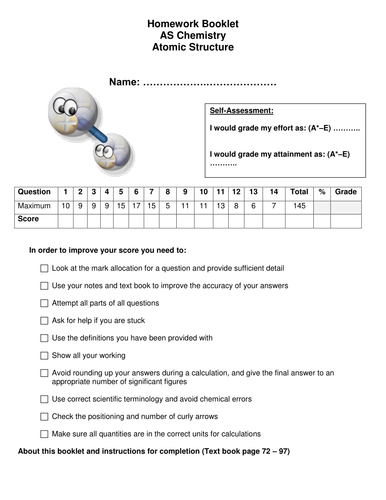






























AQA AS level Unit 1 Section 3 Bonding
Using the specification and books
No exam questions are included due to copy right
Including:
Homework booklets
Assessment sheets
Interactive powerpoints (rarely seen in A-level)
1. Ionic bonding
2. Metallic bonding
3. Covalent bonding
4. Dative covalent (co-ordinate) bonding
5 + 6 Shapes of molecules
7 Electronegativity and bond polarity
8 + 9 Forces acting between molecules (van de Waals, dipole-dipole and Hydrogen bonding)
10 States of matter and a summary of 4 types of crystal structure - molecular, macromolecular, ionic and metallic
1.
To understand how ions are formed and why they are attracted to each other
To state the properties of ionically bonded compounds
To describe the structure of ionically bonded compounds
2
To describe the nature of metallic bonding
To explain the properties of metals
To consolidate with questions
3
To describe a covalent bond
To be able to form molecules by covalent bonding
To explain the properties of covalent compounds
4.
To know what a “co-ordinate” or “dative” bond is
To be able to draw molecules with lines/arrows showing covalent/co-ordinate bonds
To consolidate with questions
5 + 6.
To state the rules that govern the shapes of simple molecules
To be able to draw and describe how the number of electron pairs around an atom affects the shape of the molecule
To describe what happens to the shape of a molecule when a bonding pair of electrons is replaced by a non-bonding pair
To describe what happens to the shape of a molecule when an ion is formed
LESSON 7 Electronegativity and bond polarity
Objectives:
To define and understand the concept of electronegativity
To understand and deduce why some covalent bonds and molecules are polar
To deduce whether a molecule has a permanent dipole
LESSON 8
Objectives:
To explain the effect of an electrostatically charged rod on different liquids
To understand there are 3 types of intermolecular forces
To explain how melting points are influenced by these intermolecular forces
LESSON 9
Objectives:
To know what is needed for hydrogen bonding to occur
To know how hydrogen bonding affects boiling points
To explain how hydrogen bonding affects other properties
LESSON 10 - can be done over 2
Objectives:
To recall the 3 states of matter
To explain the energy changes associated with changes in state
To describe in detail the structures and properties of diamond, graphite, ice, iodine, magnesium and sodium chloride
ENJOY!!!
Please rate and comment in order to further improve
Using the specification and books
No exam questions are included due to copy right
Including:
Homework booklets
Assessment sheets
Interactive powerpoints (rarely seen in A-level)
1. Ionic bonding
2. Metallic bonding
3. Covalent bonding
4. Dative covalent (co-ordinate) bonding
5 + 6 Shapes of molecules
7 Electronegativity and bond polarity
8 + 9 Forces acting between molecules (van de Waals, dipole-dipole and Hydrogen bonding)
10 States of matter and a summary of 4 types of crystal structure - molecular, macromolecular, ionic and metallic
1.
To understand how ions are formed and why they are attracted to each other
To state the properties of ionically bonded compounds
To describe the structure of ionically bonded compounds
2
To describe the nature of metallic bonding
To explain the properties of metals
To consolidate with questions
3
To describe a covalent bond
To be able to form molecules by covalent bonding
To explain the properties of covalent compounds
4.
To know what a “co-ordinate” or “dative” bond is
To be able to draw molecules with lines/arrows showing covalent/co-ordinate bonds
To consolidate with questions
5 + 6.
To state the rules that govern the shapes of simple molecules
To be able to draw and describe how the number of electron pairs around an atom affects the shape of the molecule
To describe what happens to the shape of a molecule when a bonding pair of electrons is replaced by a non-bonding pair
To describe what happens to the shape of a molecule when an ion is formed
LESSON 7 Electronegativity and bond polarity
Objectives:
To define and understand the concept of electronegativity
To understand and deduce why some covalent bonds and molecules are polar
To deduce whether a molecule has a permanent dipole
LESSON 8
Objectives:
To explain the effect of an electrostatically charged rod on different liquids
To understand there are 3 types of intermolecular forces
To explain how melting points are influenced by these intermolecular forces
LESSON 9
Objectives:
To know what is needed for hydrogen bonding to occur
To know how hydrogen bonding affects boiling points
To explain how hydrogen bonding affects other properties
LESSON 10 - can be done over 2
Objectives:
To recall the 3 states of matter
To explain the energy changes associated with changes in state
To describe in detail the structures and properties of diamond, graphite, ice, iodine, magnesium and sodium chloride
ENJOY!!!
Please rate and comment in order to further improve
Something went wrong, please try again later.
there is an awful lot in each ppt, I think the intention is very clear to the author but I felt like I needed to do quite a lot to adapt to my class, some slides are very text heavy,
Report this resourceto let us know if it violates our terms and conditions.
Our customer service team will review your report and will be in touch.
£23.00
